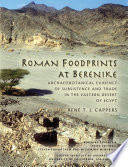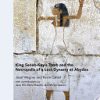Roman Foodprints at Berenike Archaeobotanical Evidence of Subsistence and Trade in the Eastern Desert of Egypt 1st Edition by René Cappers 1931745277 978-1931745277
$50.00 Original price was: $50.00.$35.00Current price is: $35.00.
Roman Foodprints at Berenike Archaeobotanical Evidence of Subsistence and Trade in the Eastern Desert of Egypt 1st Edition by René Cappers – Ebook PDF Instant Download/Delivery: 1931745277, 978-1931745277
Full download Roman Foodprints at Berenike Archaeobotanical Evidence of Subsistence and Trade in the Eastern Desert of Egypt 1st Edition after payment

Product details:
ISBN 10: 1931745277
ISBN 13: 978-1931745277
Author: René T. J. Cappers
During the Graeco-Roman period, Berenike served as a gateway to the outside world together with Myos Hormos. Commodities were imported from Africa south of the Sahara, Arabia, and India into the Greek and Roman Empire, the importance of both harbors evidenced by several contemporary sources. Between 1994 and 2002, eight excavation seasons were conducted at Berenike by the University of Delaware and Leiden University, the Netherlands. This book presents the results of the archaeobotanical research of the Roman deposits. It is shown that the study of a transit port such as Berenike, located at the southeastern fringe of the Roman Empire, is highly effective in producing new information on the import of all kinds of luxury items. In addition to the huge quantities of black pepper, plant remains of more than 60 cultivated plant species could be evidenced, several of them for the first time in an archaeobotanical context. For each plant species detailed information on its (possible) origin, its use, its preservation qualities, and the Egyptian subfossil record is provided. The interpretation of the cultivated plants, including the possibilities of cultivation in Berenike proper, is supported by ethnoarchaeobotanical research that has been conducted over the years. The reconstruction of the former environment is based on the many wild plant species that were found in Berenike and the study of the present desert vegetation.
Roman Foodprints at Berenike Archaeobotanical Evidence of Subsistence and Trade in the Eastern Desert of Egypt 1st Table of contents:
Chapter 1 – Rome’s Eastern Trade (pp. 9–20)
At its peak, the Roman Empire encompassed an unbroken region around the Mediterranean Sea. Its northern boundaries stretched to Hadrian’s Wall in Britain and the Rhine and Danube rivers in Europe, while the eastern frontier included territories of modern Turkey, Iraq, Syria, Lebanon, Jordan, and Israel. In Africa, the Empire’s reach was relatively limited except for Egypt, where Rome pursued strategic interests tied to the Nile’s agricultural and economic significance.
Chapter 2 – Natural Vegetation (pp. 21–37)
The Eastern Desert of Egypt is an arid landscape characterized by minimal rainfall and extreme temperatures. Despite the harsh climate, the region harbors diverse flora supported by localized water sources. Variations in vegetation patterns reflect adaptations to this hyperarid environment, which includes the Red Sea coastal plains and surrounding mountains.
Chapter 3 – Living in the Desert (pp. 38–48)
Life in desert environments requires resourceful adaptation to limited water availability. Nomadic groups in the Eastern Desert historically organized themselves around subsistence strategies suited to the region’s carrying capacity. The arid climate, established during the Holocene, profoundly influenced their cultural and material practices.
Chapter 4 – Archaeobotanical Research (pp. 49–138)
Archaeobotanical studies differentiate between the cultivation of wild plants and domestication processes, where human intervention transforms plants for dependency and productivity. Domesticated species often display morphological changes observable in subfossil remains, providing insights into ancient agricultural practices and trade networks.
Chapter 5 – Peaches in the Desert (pp. 139–151)
The port city of Berenike served as a vital hub for trade and food logistics at the southeastern edge of the Roman Empire. Due to the arid environment, its sustenance relied heavily on long-distance transportation. Trade routes were meticulously coordinated with sailing schedules and provisions for both inhabitants and caravans.
Chapter 6 – Interpretative Summary and Conclusion (pp. 152–168)
Excavations at Berenike and Shenshef revealed a diverse archaeobotanical record, including 68 cultivated plant species and over 110 wild taxa. Differences in species between the sites reflect variations in excavation efforts and local environmental conditions. This record sheds light on agricultural practices, trade, and ecological adaptations in ancient Egypt.
Chapter 7 – Catalogue of Taxa (pp. 169–180)
This section details subfossil plant specimens from Berenike and Shenshef. Rare and fragmented remains were prioritized for inclusion, supported by comparisons to modern specimens. Morphological and anatomical characteristics of these remains provide valuable insights into ancient flora and their uses.
People also search for Roman Foodprints at Berenike Archaeobotanical Evidence of Subsistence and Trade in the Eastern Desert of Egypt 1st:
roman archaeology finds
ancient footprints africa
ancient footprints of acahualinca
ancient footprints at white sands
Tags:
René Cappers,Roman Foodprints,Berenike Archaeobotanical Evidence


